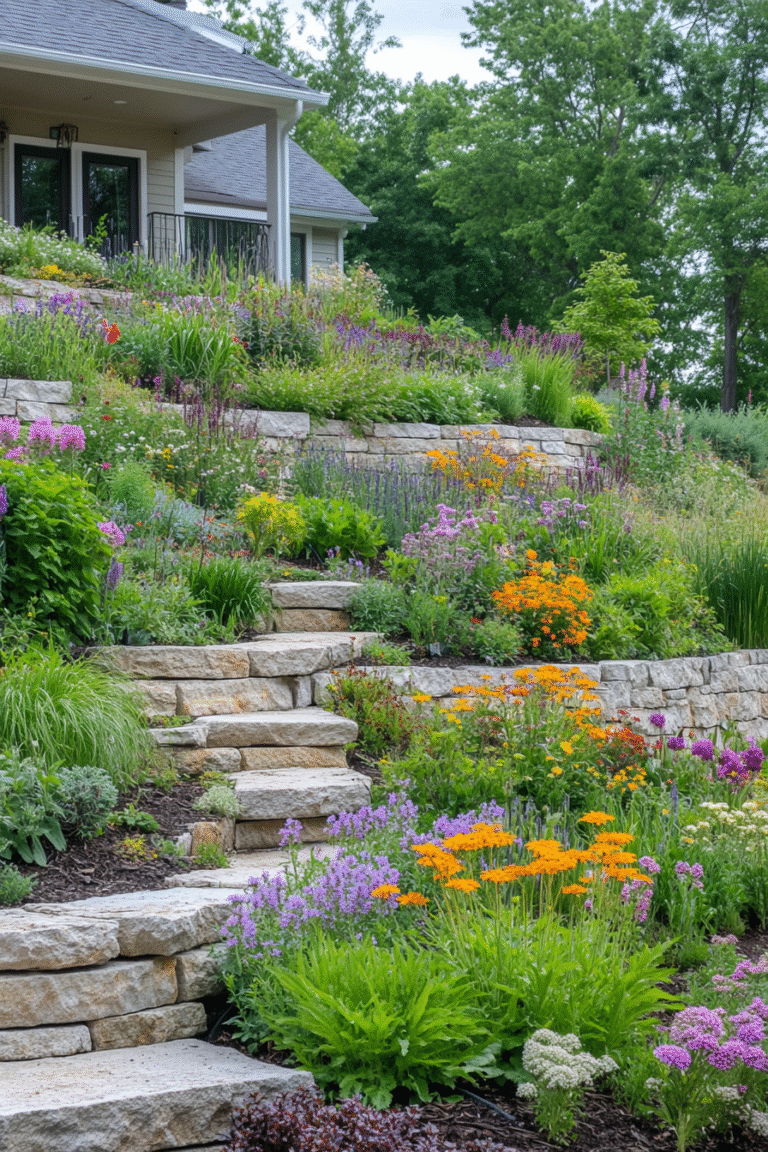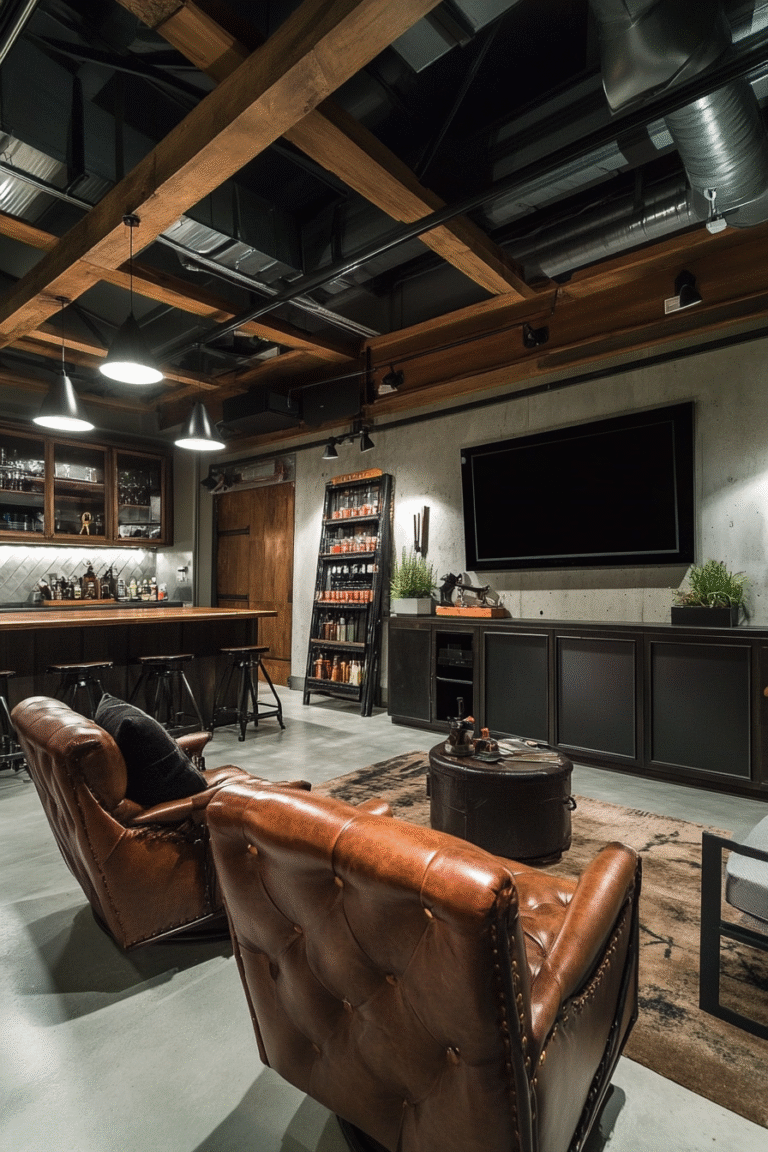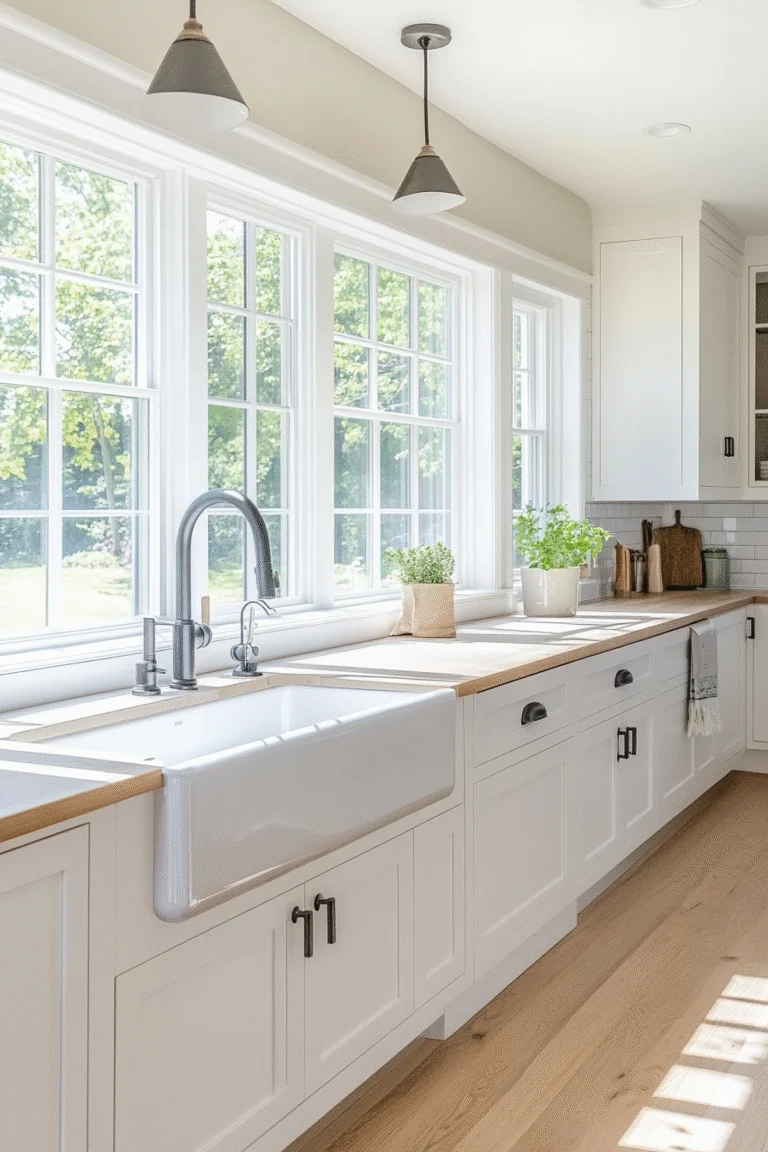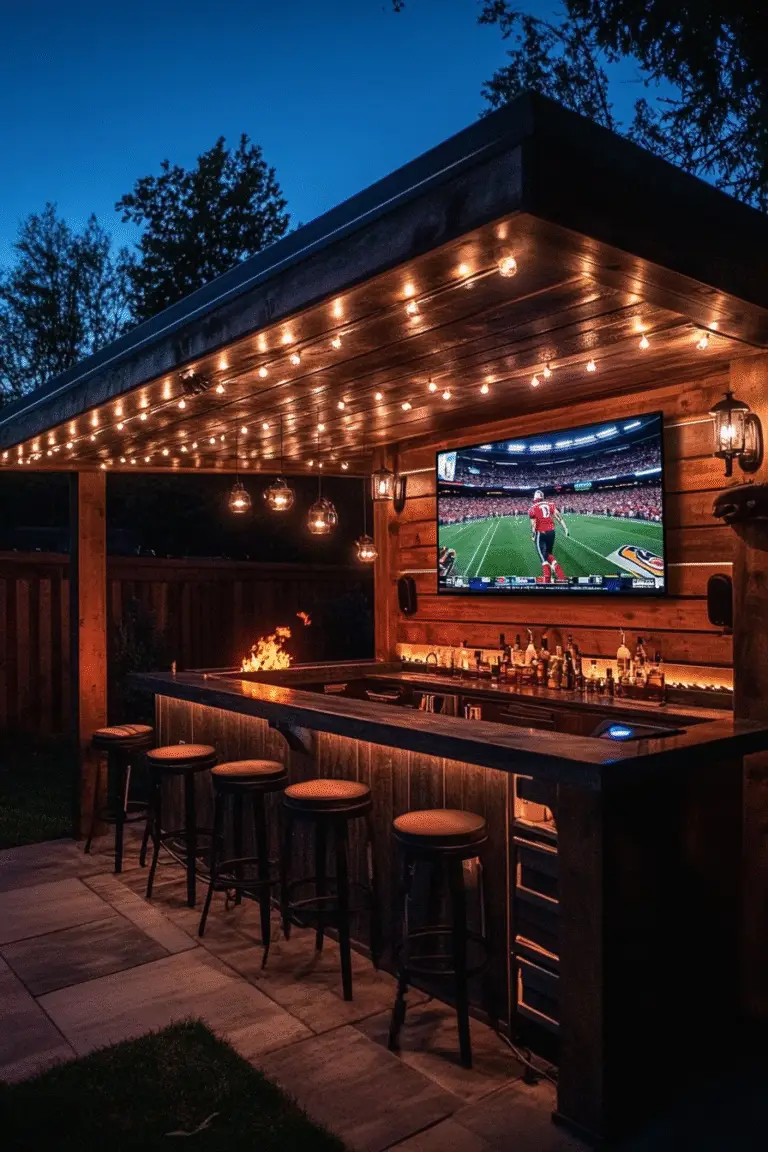Black garage gym ideas aren’t just about making your space look cool on Instagram—they can make or break your home’s value. After two decades as a licensed REALTOR®, I’ve walked buyers through hundreds of garage gym conversions, and the difference is always clear. The setups that add value are professionally planned, properly executed, and designed with real homes in mind. The ones that don’t? They cost sellers thousands in missed opportunities.
The truth is, a garage gym done right isn’t a passing trend—it’s a legitimate home improvement that boosts buyer appeal. This guide blends design inspiration with the professional insights I share with clients every day, showing you how to build a gym that looks incredible and adds lasting value to your property.
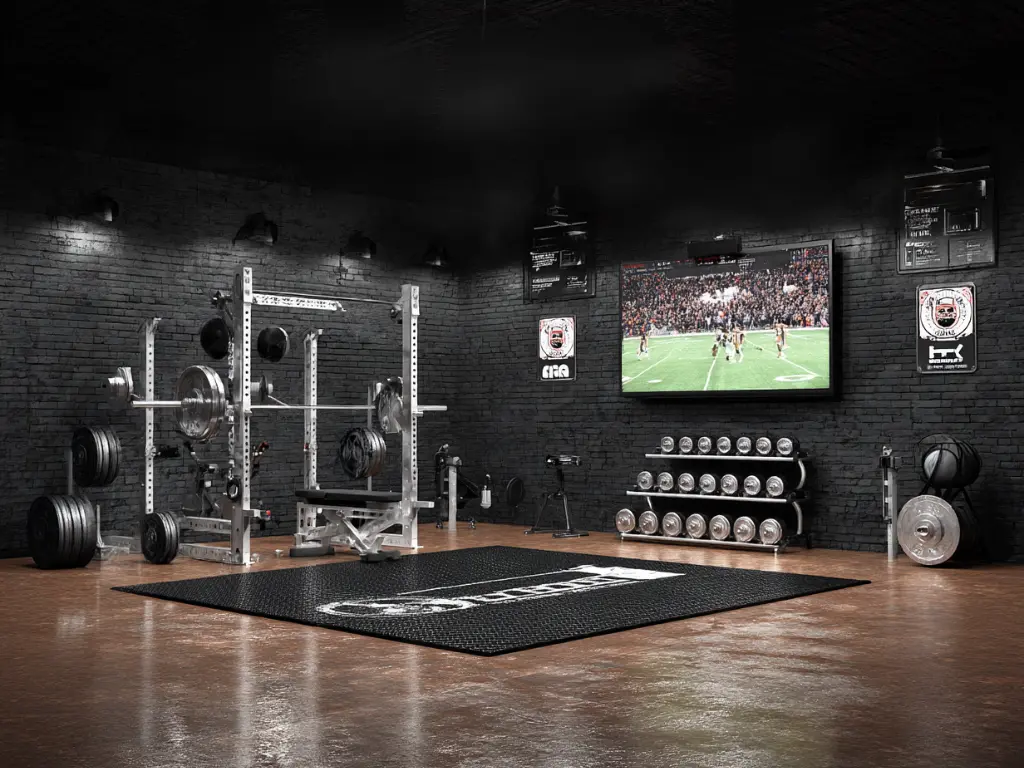

Table of Contents
Black Garage Gym Ideas That Add Value
In my experience showing homes, the gym conversions that boost buyer interest share specific characteristics. They’re professionally planned, properly ventilated, and easily convertible back to parking if needed. When a garage gym feels like a thoughtful upgrade instead of a permanent sacrifice, buyers light up. The most successful setups I’ve seen follow these principles:
Space Planning Formula:
- Minimum 200 sq ft for basic home gym functionality
- 300–400 sq ft for comprehensive setups with multiple zones
- Leave 8–10 feet clearance for car access if dual-purpose
- 12-foot ceiling minimum for Olympic lifts and overhead exercises
Property Value Impact:
Well-executed garage gyms can add 5–15% buyer interest in suburban markets, particularly in areas where outdoor fitness space is limited. But when planning gets sloppy—like eliminating all parking or skipping ventilation—I’ve watched sellers lose 20–30% of their buyer pool. In real estate terms, that’s the difference between a “wow” feature and a deal breaker.
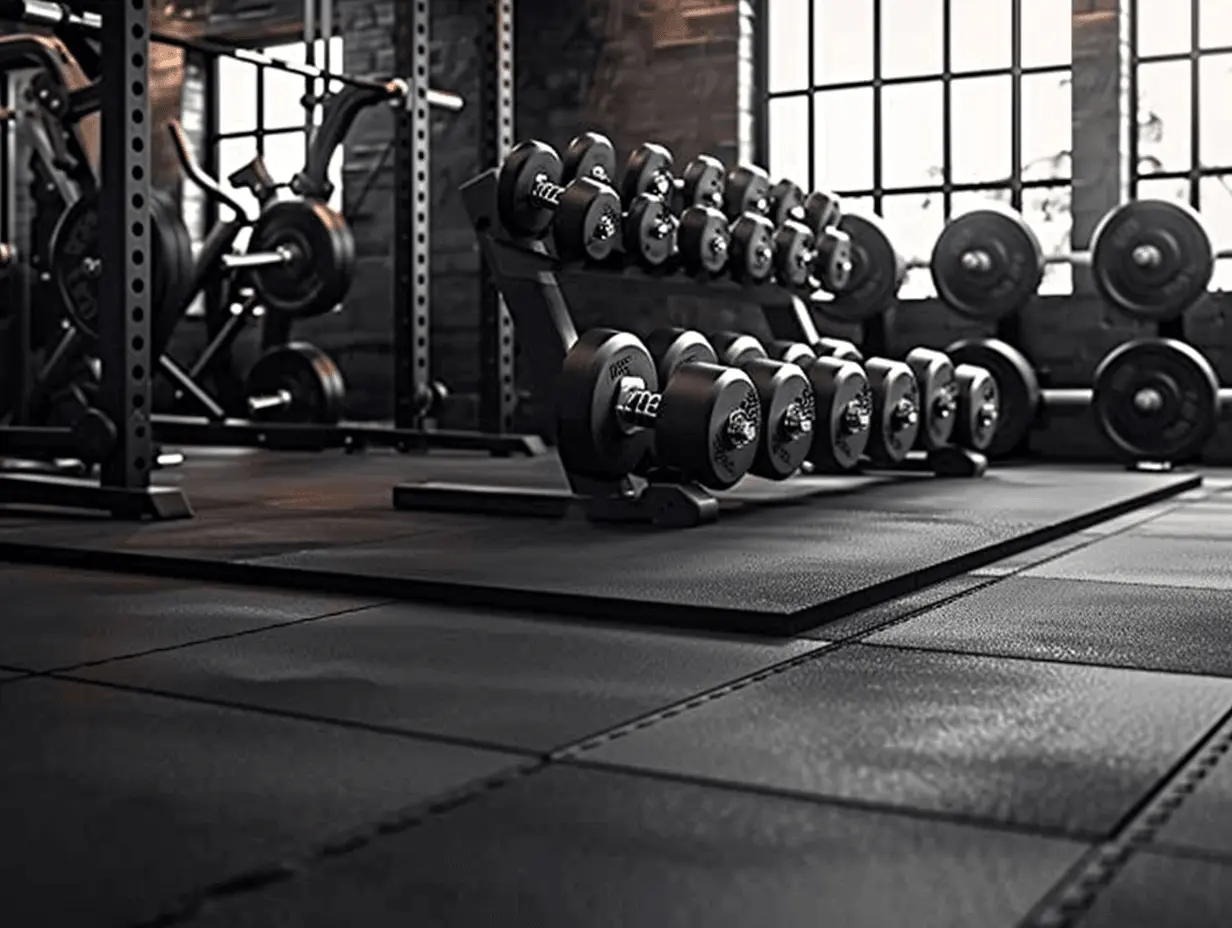

Home Gym Lighting Beyond Basic Brightness
Lighting makes or breaks the space. Poor lighting doesn’t just make workouts miserable—it makes the room feel unsafe and uninviting, which is an instant buyer turnoff.
Lighting Requirements Formula:
- General lighting: 50–75 lumens per sq ft minimum
- Task lighting: 100+ lumens per sq ft over workout areas
- Color temperature: 4000–5000K for energy and focus
- Electrical: Plan for 20-amp circuits to support high-output LED systems
Professional Installation Considerations:
The Barrina LED Shop Light System provides 5,500 lumens per fixture and links together for even coverage—ideal for a 300 sq ft garage gym. Plan for 4–6 fixtures minimum, and wire them on separate switches so you can toggle between general lighting and high-intensity workout sessions.
Safety & Code Compliance:
- GFCI protection required for all garage outlets
- Dedicated circuits prevent overload
- Major electrical work typically requires a permit
- Proper grounding and emergency shut-offs reduce risk
- Keep a Class C fire extinguisher and first aid kit accessible
Insurance Considerations:
Notify your homeowner’s insurance about significant upgrades—proper installation can qualify for safety discounts, while DIY shortcuts are red flags for appraisers and buyers alike. DIY shortcuts can tank buyer trust during inspections.
Want more ways to make your home work harder for you? Don’t miss our guide to Outdoor Man Cave Ideas for creating a backyard escape that pairs perfectly with your black garage gym.
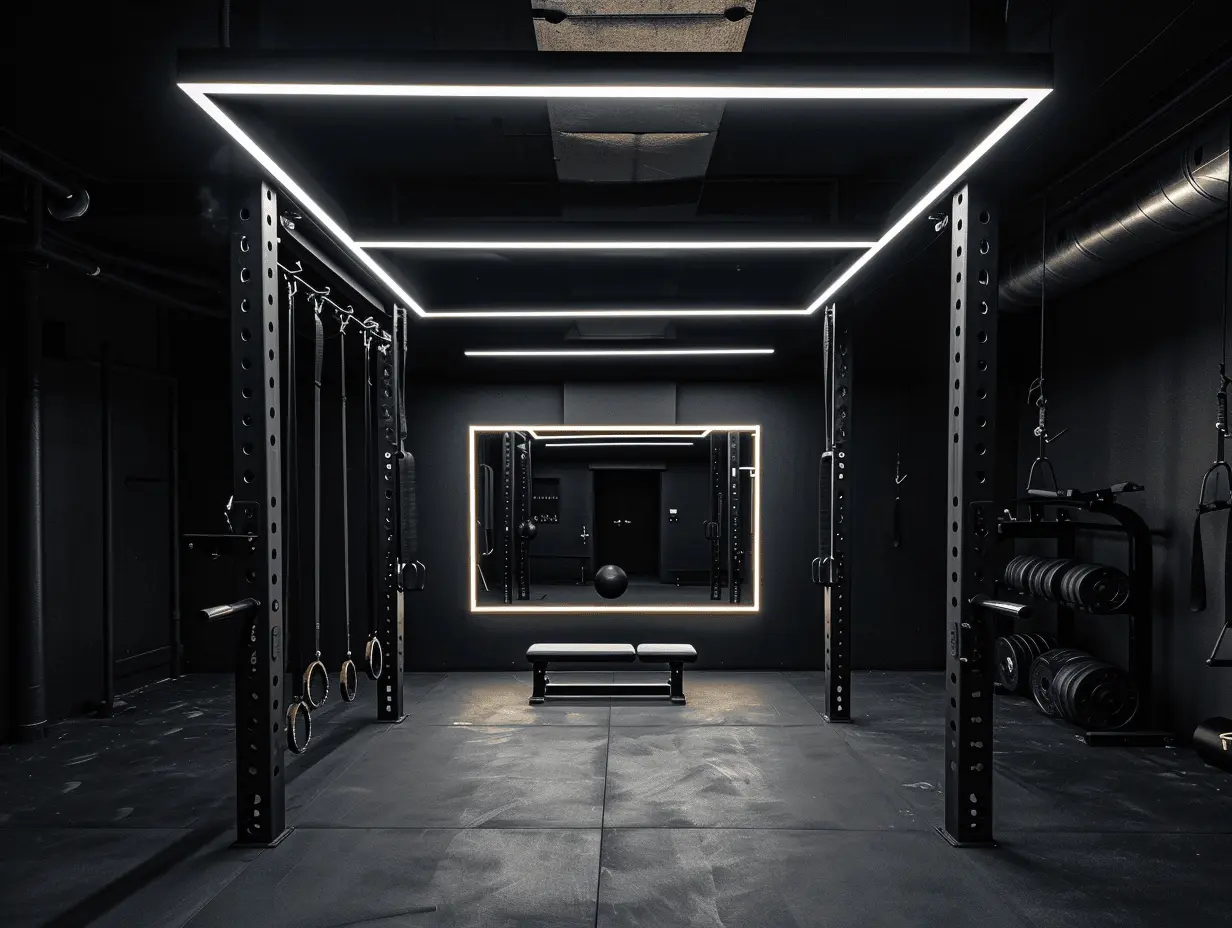

Oh — and fun fact? This very garage gym post was recently featured by Robust Magazine for its “badass look” (their words, but hey… no lies detected). It’s been wild to see this space get some love, and it just goes to show: when form and function work together, people notice.
Flooring That Protects Your Investment: Black Gym Flooring Done Right
The flooring mistakes I see during home showings are brutal—for both safety and your home’s foundation. I’ve watched cracked concrete from dropped weights kill buyer interest, and those repairs can run into the thousands.
Professional Flooring Specifications:
- Rubber thickness: ⅜” minimum for light weights, ¾” for Olympic lifting
- Durometer rating: 60–80 Shore A for proper shock absorption
- Installation: Floating floors allow easy removal if buyers want parking back
- Coverage: Full coverage under equipment, strategic placement elsewhere
Load Distribution Formula:
For heavy equipment (1,000+ lbs), spread the weight across at least 16 sq ft. A power rack should sit on a 4’×4′ platform to prevent fractures in the slab.
Budget-Smart Options:
The flooring I recommend most often is interlocking rubber tiles—removable (a big plus for resale), protective, and affordable at $2–4 per sq ft installed versus $8–12 for poured options. A reliable choice is the BalanceFrom Puzzle Exercise Mat – thick enough for lifting, easy to clean, and simple to remove if the garage goes back to parking.
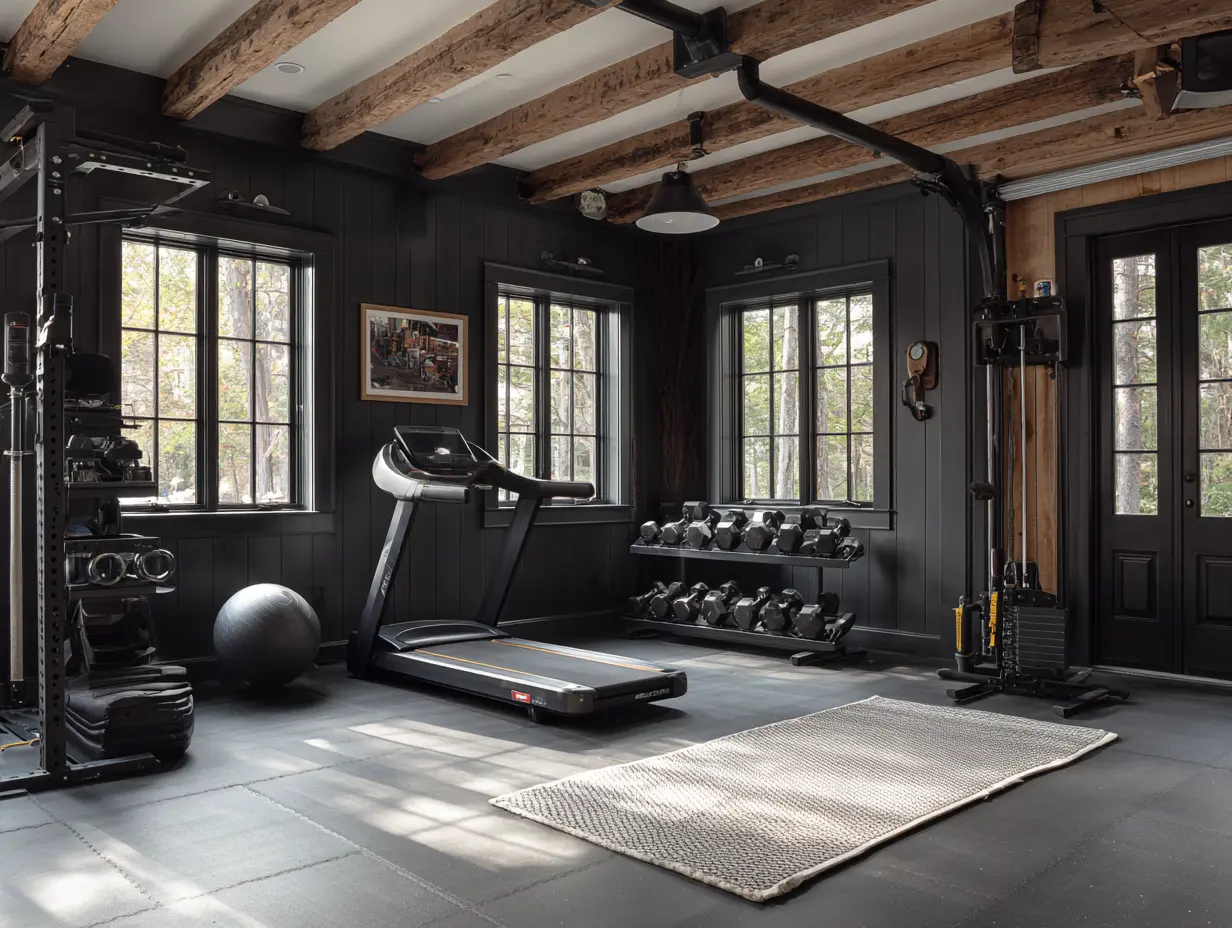

If you’re dreaming bigger than barbells and want your garage to pull double duty as a retreat and a workout zone, check out our Garage Man Cave Ideas post. It’s packed with ideas that make your space work just as hard when you’re off the squat rack.
Ventilation Engineering: More Than Just Opening Doors
Poor ventilation is the fastest way to turn a garage gym into a liability. I’ve seen it in inspections—moisture that damages equipment, rots drywall, and leads to $5,000–$15,000 mold remediation. Buyers don’t just notice that—they walk away.
Ventilation Requirements:
- Air changes: 6–8 per hour during use
- CFM: (Sq ft × ceiling height × 8) ÷ 60 = minimum needed
- Exhaust: High-mounted fans to push hot, humid air out
- Intake: Opposite-side natural or mechanical intake for balance
Professional Solutions:
For a 300 sq ft garage with 10-foot ceilings, you’ll need about 400 CFM capacity. The Broan-NuTone High-Capacity Exhaust Fan delivers airflow without the noise. Pair it with vapor barriers on shared walls to prevent moisture creeping into the house—because once mold sets in, it’s a deal breaker.
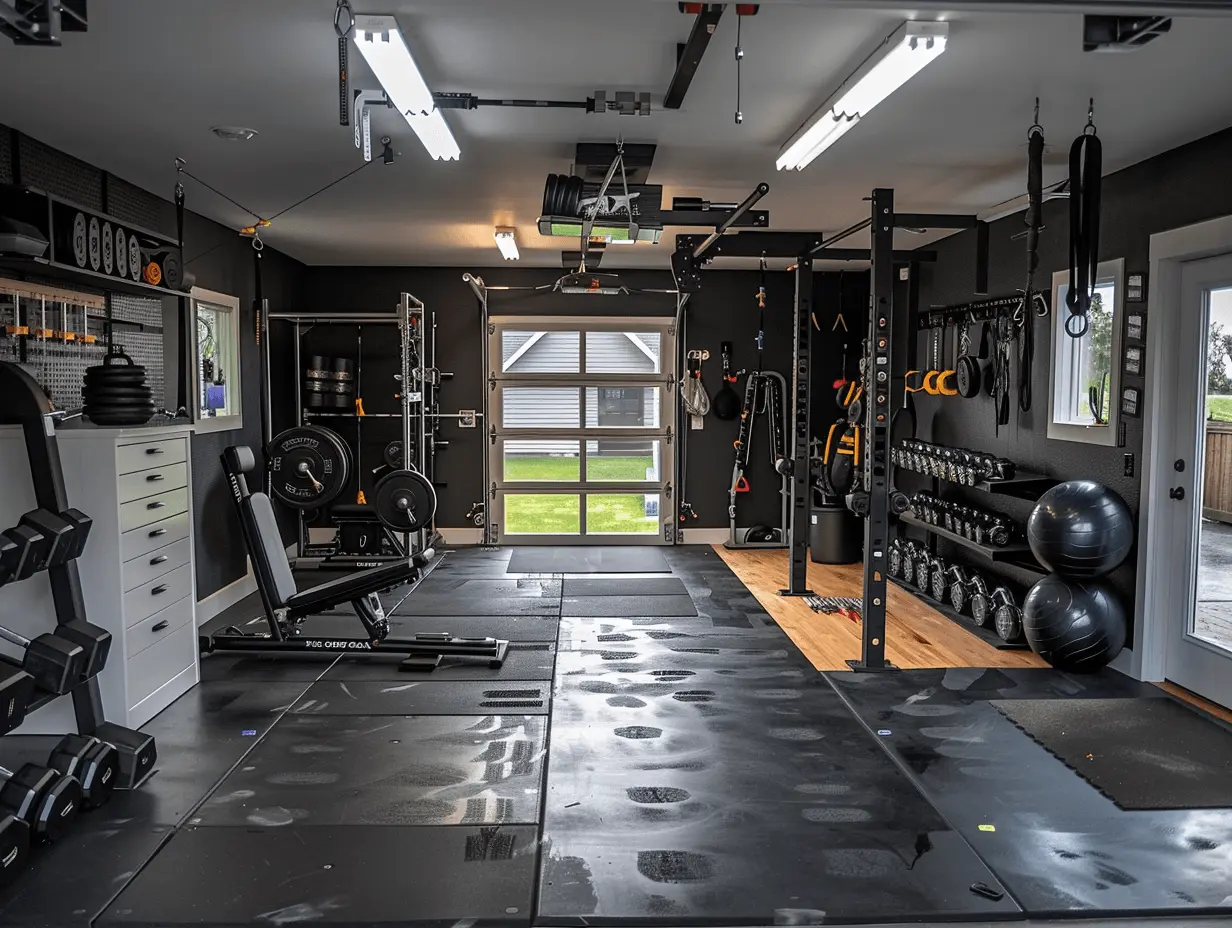

Equipment Selection: Value-Focused Choices for Black Garage Gym Ideas
Clients often ask which gear adds value versus what just looks like clutter. I can tell you this: the right equipment looks intentional and professional, while the wrong pieces drag buyer appeal down fast. When it looks, ‘cheap,’ buyers see it instantly. Something doing is worth doing right.
High-Value Equipment (Appeals to Most Buyers):
- Adjustable rack systems that don’t require floor mounting
- Compact, multi-function setups
- Professional-grade cardio with small footprints
- Storage systems that maximize organization
Buyer Turnoffs:
- Equipment that needs permanent floor bolting
- Oversized, single-purpose machines
- Non-removable installs that block parking
- Poor-quality or worn gear
Smart Budget Allocation:
- 40% on flooring and safety
- 30% on lighting and ventilation
- 20% on core equipment
- 10% on storage and organization
A great example of high-value equipment is the CAP Barbell 300 LB Cast Iron Olympic Weight Set — strong plates, full-size bar, recognizable quality for buyers, and it doesn’t scream “single-purpose”, meaning it adds value without overbuilding.
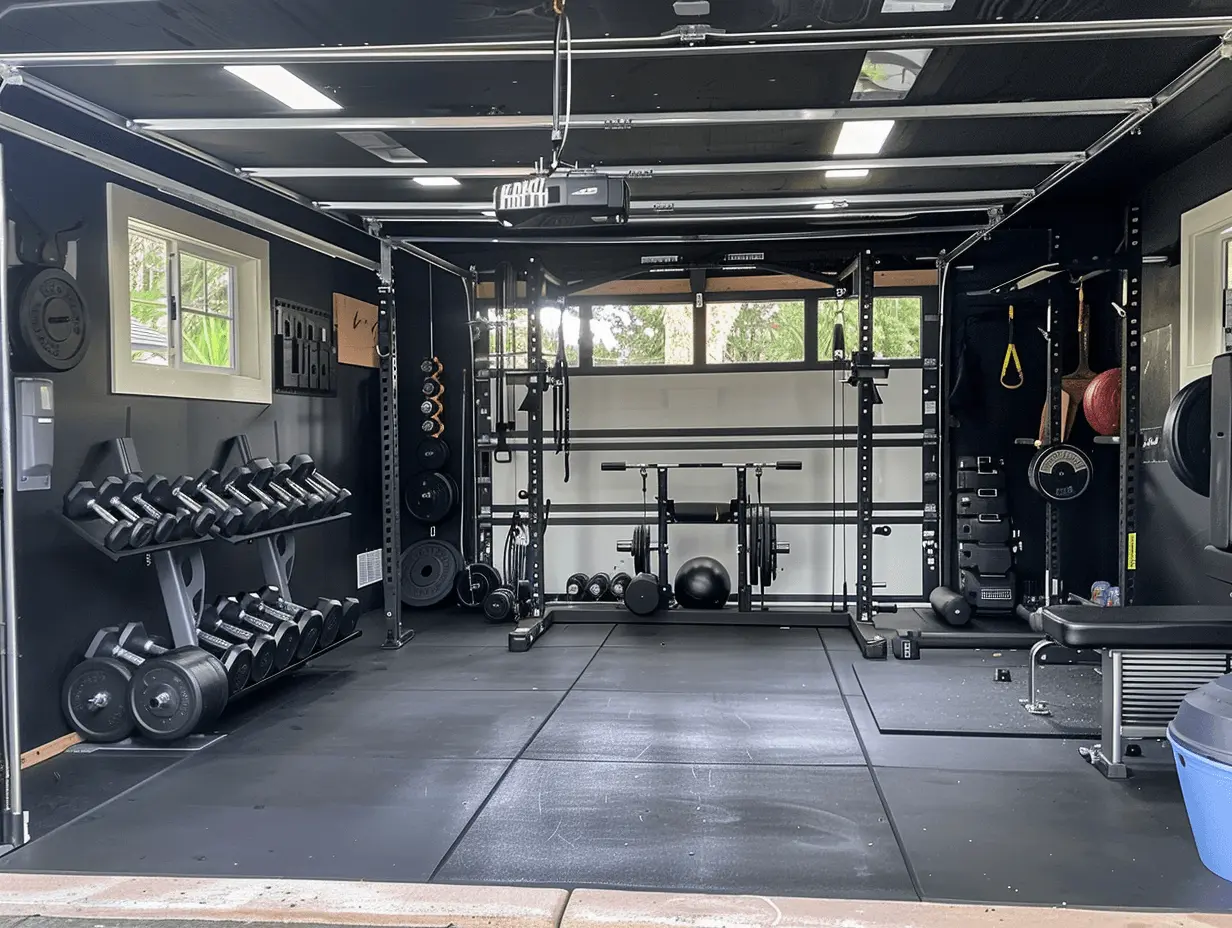

Storage Solutions: Garage Gym Storage That Adds Value
Buyers consistently comment on well-organized garage spaces during showings. The garage doesn’t even need a gym in it. Storage matters for buyers. Smart storage makes equipment accessible while still leaving room for vehicles—a selling point that directly impacts resale value.
Professional Storage Formula:
- Vertical storage: 70% of equipment should store vertically
- Floor space: Keep 60% clear if the garage stays dual-purpose
- Weight capacity: Systems should handle 2× intended load
- Accessibility: Daily-use items within 4–6 feet of the floor
High-Value Storage Solutions:
Wall-mounted systems like the StoreWALL Heavy Duty Kit offer professional-grade organization that’s versatile and removable—buyers love that it doesn’t lock them into a permanent setup.
Organization Zones:
- Maintenance Zone – cleaning supplies, basic tools
- Active Equipment Zone – daily use items
- Seasonal Storage Zone – less frequent equipment
- Safety Equipment Zone – first aid, emergency items
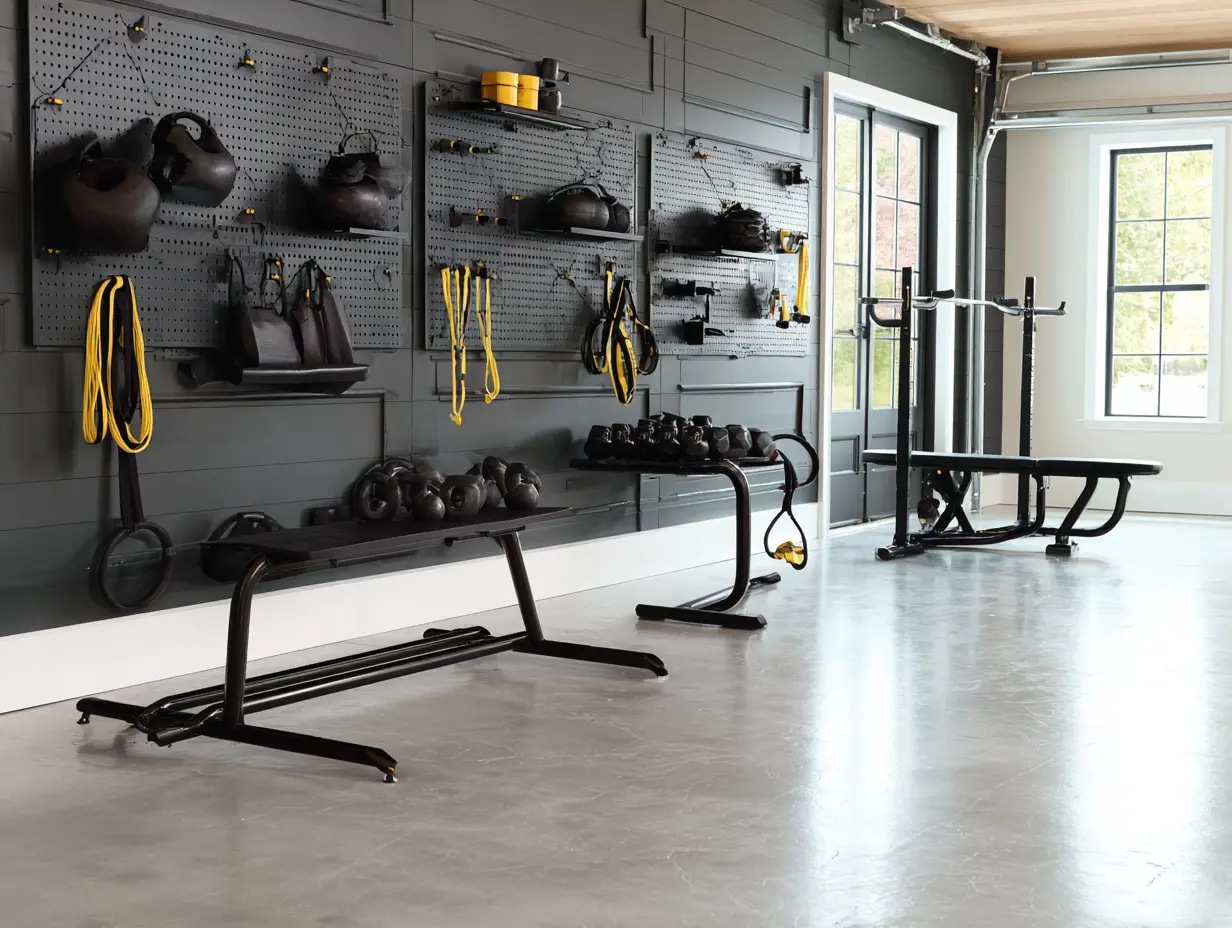

Craving inspo beyond the garage? Explore our guide to Outdoor Man Cave Ideas That Bring the Backyard to Life and see how your exterior spaces can flex just as hard as your black garage gym.
Creating Multi-Zone Functionality in Your Garage Gym Conversion
The most successful garage gyms I’ve seen are professionally zoned for multiple activities. This approach maximizes function for the current owner while maintaining flexibility for future buyers—a crucial detail in any conversion.
Zone Planning Formula:
- Strength zone: 25% of space, near power sources
- Cardio zone: 20% of space, near ventilation
- Recovery/flexibility zone: 15% of space, in a quieter corner
- Storage zone: 15% of space, using vertical organization
- Circulation space: 25% of space, to maintain flow
Professional Layout Considerations:
- Place load-bearing equipment near structural walls
- Keep high-impact activities away from shared walls with living spaces
- Maintain emergency egress paths to meet fire code
- Ensure electrical panel accessibility is never blocked
Buyer Appeal Strategy:
Zone planning isn’t just about today’s workout—it’s about tomorrow’s resale. A recovery area can double as a workshop, strength zones can convert to storage, and circulation planning preserves parking. That kind of foresight is what turns a good gym into a smart investment.
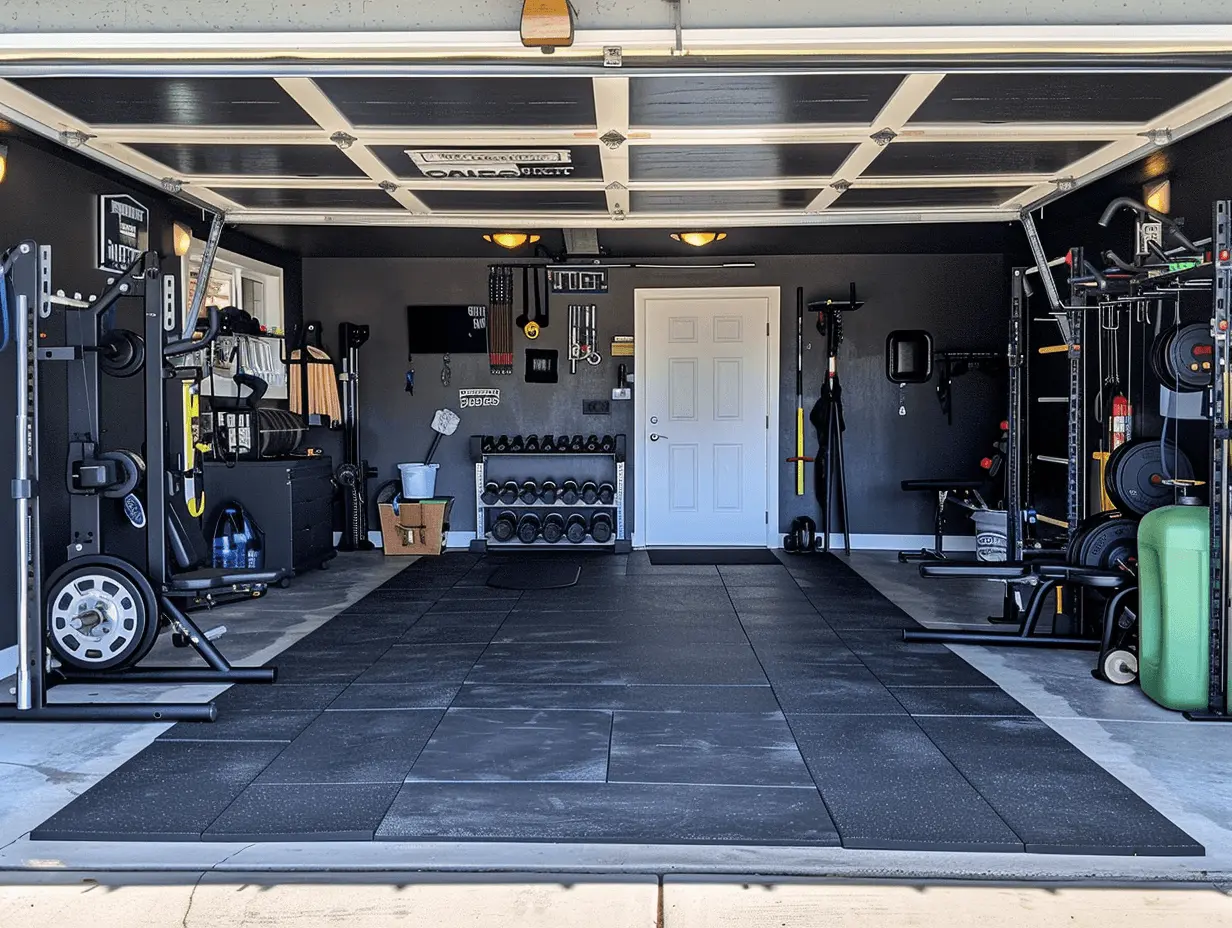

Maintenance and Longevity: Protecting Your Investment
Proper maintenance doesn’t just preserve equipment—it protects your property value. In home inspections, well-maintained garage gyms consistently score higher in buyer appeal, and keeping up with the basics is part of what makes truly budget-friendly home gym ideas stand out.
Professional Maintenance Schedule:
| Schedule | Tasks | Why It Matters |
|---|---|---|
| Daily (5 min) | Wipe down equipment, sweep floors, check ventilation | Prevents corrosion, keeps air moving |
| Weekly (30 min) | Deep clean rubber flooring (Chemical Guys Rubber Mat Cleaner), inspect equipment, reorganize storage | Protects equipment + maintains safety |
| Monthly (2 hrs) | Clean ventilation system, calibrate equipment, check for wear | Stops small issues from turning into big repairs |
| Seasonal (4 hrs) | Full system inspection, touch up paint, HVAC maintenance, deep clean storage | Keeps space buyer-ready + long-term value strong |
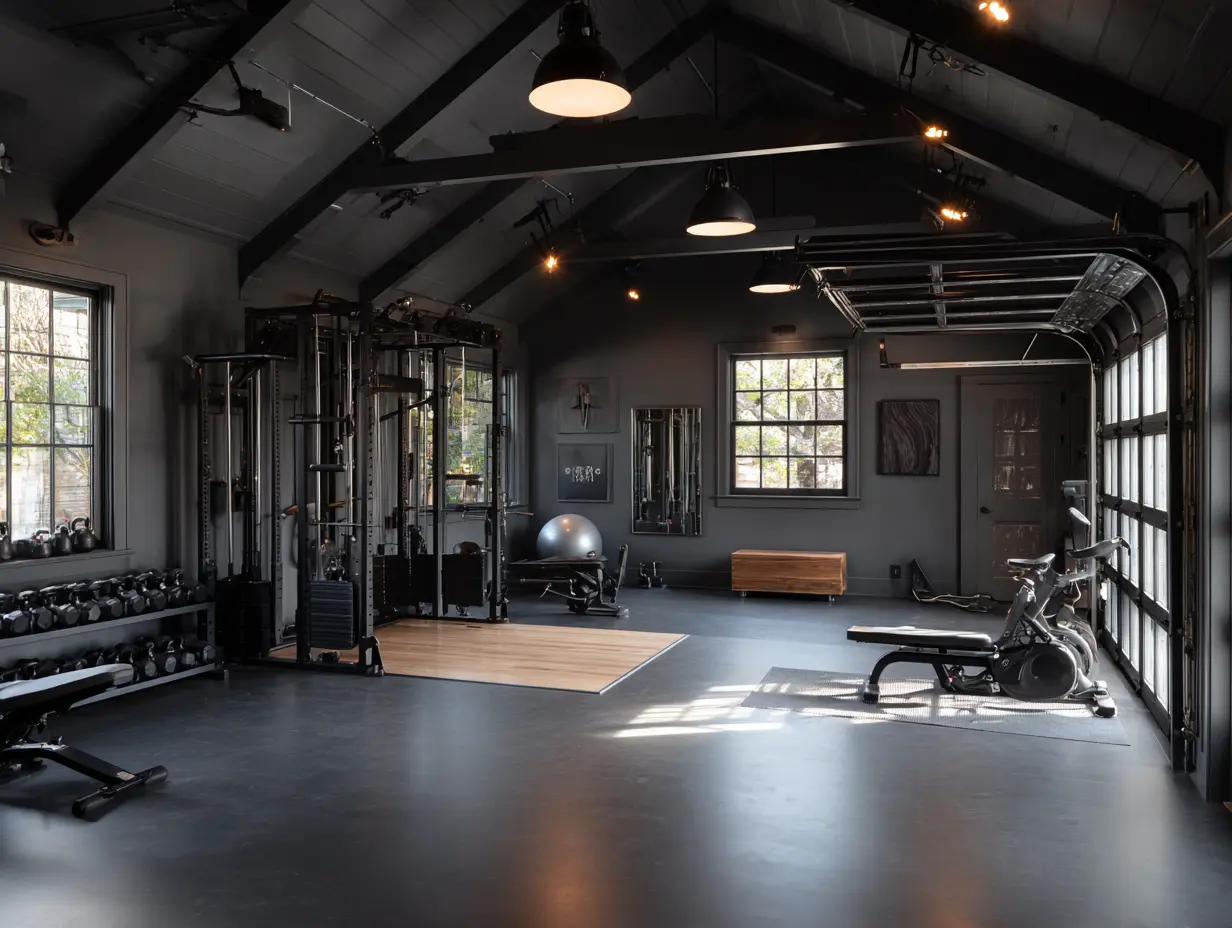

Budget Planning: Professional Investment Strategy
Based on my experience with property values and ROI, here’s the professional budget allocation strategy I recommend to clients. Smart planning ensures your black garage gym ideas don’t just look good—they hold long-term value and appeal to future buyers.
Investment Tiers:
| Tier | Cost Range | Key Upgrades | Buyer Value |
|---|---|---|---|
| Tier 1 – Essentials | $2,000–$4,000 | Electrical/code compliance, 50+ lumens lighting, basic rubber flooring, ventilation | Safety-first, prevents deal-breakers |
| Tier 2 – Value-Added | $4,000–$8,000 | Premium flooring, smart climate control, pro storage systems, core equipment | Increases buyer appeal + function |
| Tier 3 – Luxury | $8,000+ | Smart home integration, premium AV, high-end equipment, custom storage | Lifestyle upgrade, competitive edge in higher-end markets |
ROI Considerations:
Well-executed gyms typically can return ROI of investment through buyer interest and faster sales. However: overspending beyond neighborhood standards can backfire, which is why layering in budget-friendly home gym ideas matters just as much as the big-ticket upgrades. And always keep in mind a large hand full of buyers actually want the garage space. Just something to consider.
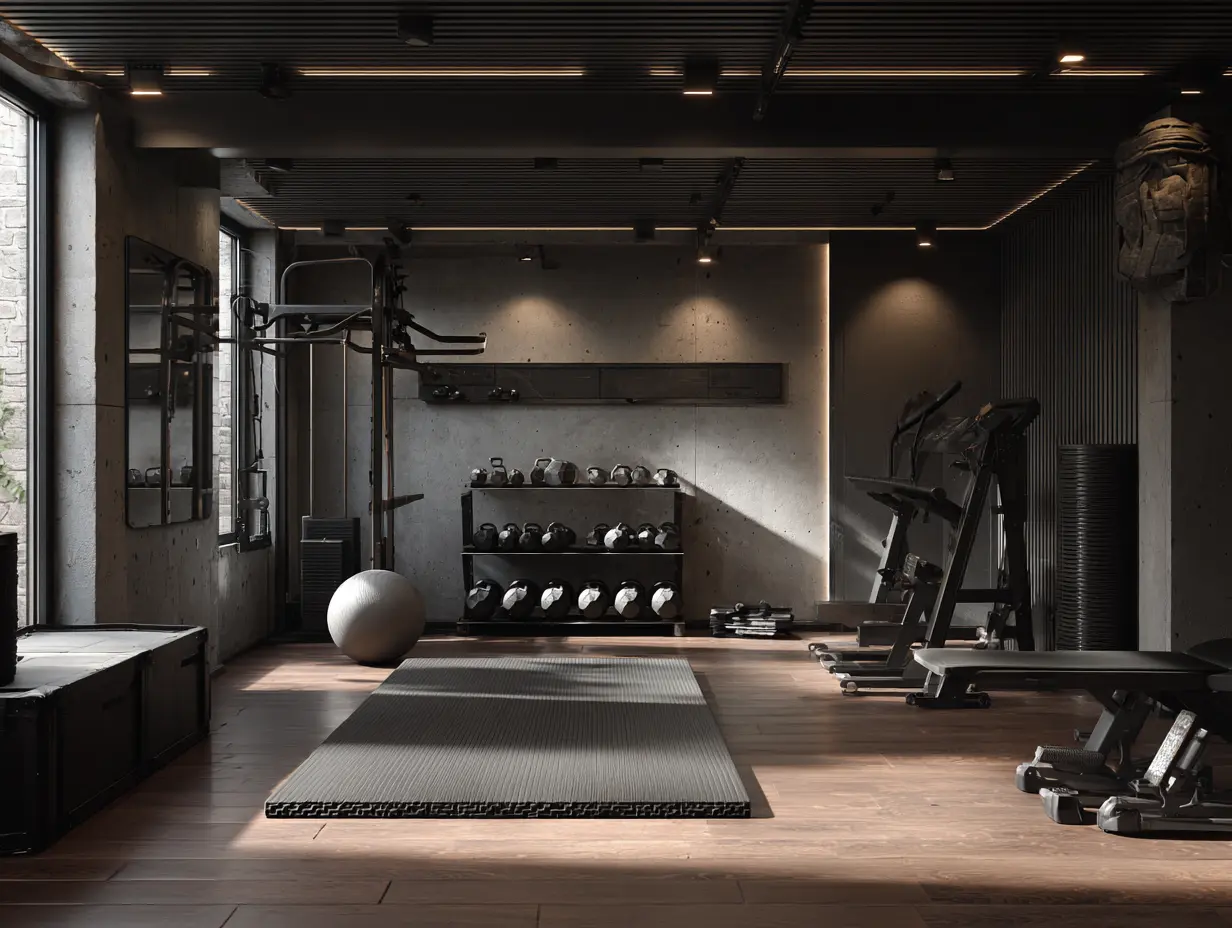

Common Mistakes That Cost Property Value
Being in the real estate business for 20+ years, I’ve seen plenty of conversions go sideways. These are the mistakes that consistently reduce buyer interest and tank property value:
Critical Errors to Avoid:
- Permanent modifications that eliminate parking capability
- Inadequate electrical work that creates safety hazards
- Poor ventilation leading to moisture and mold issues
- Code violations that complicate property transfers
- Over-improvement beyond neighborhood standards
Professional Solutions:
- Design for easy reconversion to parking
- Use licensed professionals for electrical and structural work
- Obtain necessary permits for major modifications
- Focus on improvements that appeal to a broader buyer base
Buyer Psychology Insights:
Buyers prefer garage gyms that feel like intentional home improvements, not improvised storage areas. Professional planning, quality execution, and proper maintenance create first impressions that turn into offers.
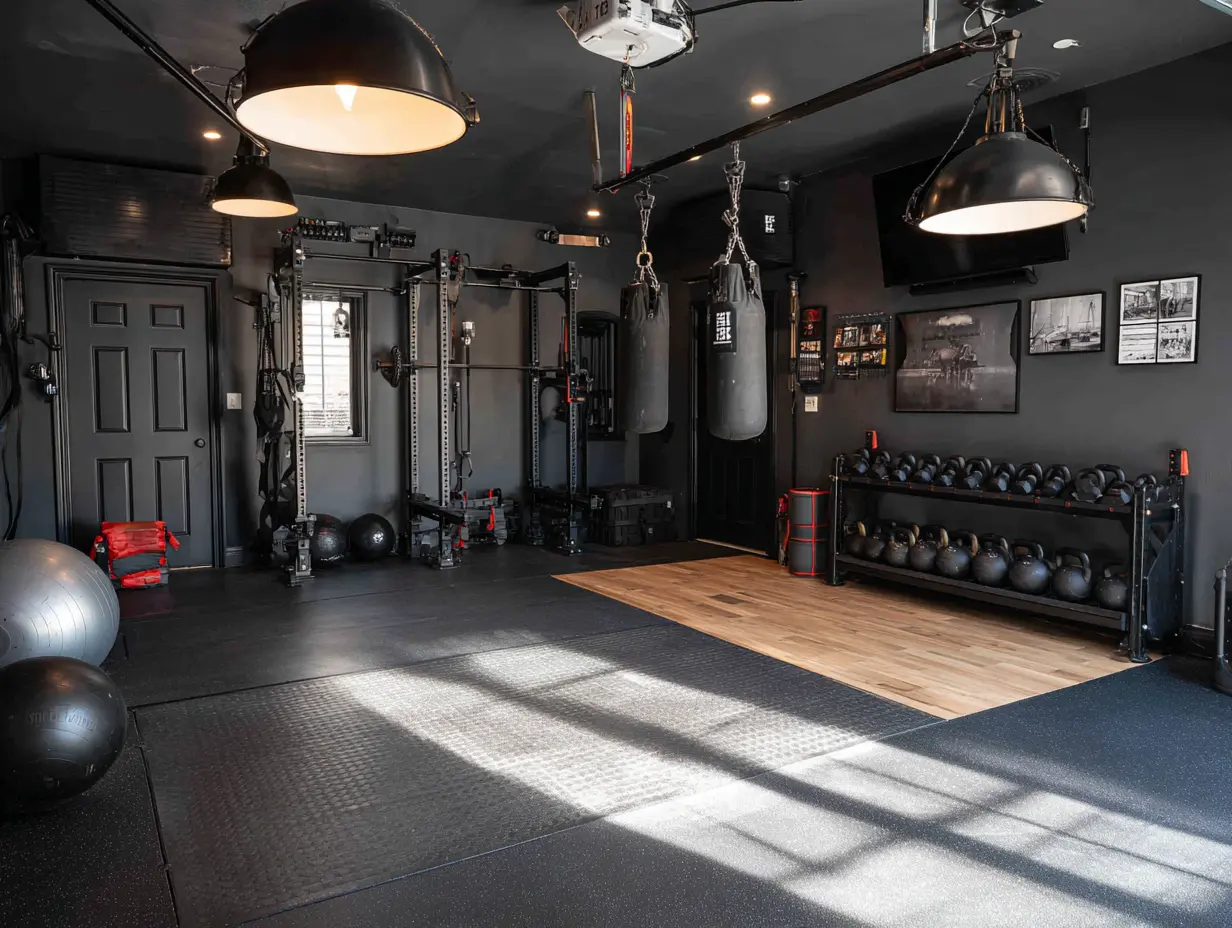

Frequently Asked Questions: Professional Insights
How much value does a garage gym design add to my home?
A well-executed garage gym can boost buyer interest by 5–15% in suburban markets. (If the buyer loves a gym). Poorly planned setups that remove parking often reduce buyer appeal.
What permits do I need for a conversion?
Electrical work requires permits, and structural, plumbing, or HVAC changes do as well. Always confirm with local authorities and use licensed professionals.
Should I make the conversion permanent or removable?
Removable installations maintain the most buyer appeal. Opt for floating flooring, wall-mounted (not bolted) equipment, and flexible storage.
How do I know if my garage structure can handle gym equipment?
Most slabs handle distributed loads, but consult a structural engineer for gear over 1,000 lbs or any floor-mounted installs.
What insurance considerations should I know about?
Inform your homeowner’s insurance of major additions. High-value equipment may need extra coverage, while proper electrical and safety upgrades can qualify for discounts.
Your Garage Gym Journey Starts Now
Here’s the truth about every garage I’ve walked buyers through: it’s never about perfection, it’s about potential. Black garage gym ideas work best when they start with the essentials—durable flooring, bright lighting, and smart storage—and grow into something that feels intentional. Those bold, layered setups? That’s where the personality comes in.
The most valuable gyms I’ve seen aren’t built overnight. They evolve—gear added when it’s needed, layouts shifting as workouts change, design tuned to keep the space motivating. The real win is creating a garage that supports your life now while adding appeal for whoever comes after. The aesthetic is the bonus; the long-term value is the payoff.
Psst… want even more gym ideas? Check out RealHomes’ Garage Gym Ideas for serious inspiration that pairs perfectly with everything you’re doing here. Like adding a protein shake to your pre-workout — but make it interior design.
